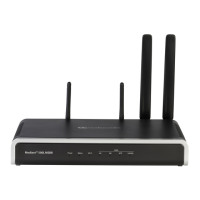User's Manual 24. Digital PSTN
Version 6.8 367 Mediant 500L MSBR
24.5 Tunneling Applications
This section discusses the device's support for VoIP tunneling applications.
24.5.1 QSIG Tunneling
The device supports QSIG tunneling over SIP, according to IETF Internet-Draft draft-elwell-
sipping-qsig-tunnel-03 ("Tunnelling of QSIG over SIP") and ECMA-355/ISO/IEC 22535.
This is applicable to all ISDN variants. QSIG tunneling can be applied to all calls or to
specific calls using IP Profiles.
Note: TDM tunneling is applicable to BRI.
QSIG tunneling sends all QSIG messages as raw data in corresponding SIP messages
using a dedicated message body. This is used, for example, to enable two QSIG
subscribers connected to the same or different QSIG PBX to communicate with each other
over an IP network. Tunneling is supported in both directions (Tel-to-IP and IP-to-Tel).
The term tunneling means that messages are transferred ‘as is’ to the remote side without
being converted (QSIG > SIP > QSIG). The advantage of tunneling over QSIG-to-SIP
interworking is that by using interworking, QSIG functionality can only be partially achieved.
When tunneling is used, all QSIG capabilities are supported and the tunneling medium (the
SIP network) does not need to process these messages.
QSIG messages are transferred in SIP messages in a separate Multipurpose Internet Mail
Extensions (MIME) body. Therefore, if a message contains more than one body (e.g., SDP
and QSIG), multipart MIME must be used. The Content-Type of the QSIG tunneled
message is ‘application/QSIG’. The device also adds a Content-Disposition header in the
following format:
Content-Disposition: signal; handling=required.
QSIG tunneling is done as follows:
Call setup (originating device): The QSIG Setup request is encapsulated in the SIP
INVITE message without being altered. After the SIP INVITE request is sent, the
device does not encapsulate the subsequent QSIG message until a SIP 200 OK
response is received. If the originating device receives a 4xx, 5xx, or 6xx response, it
disconnects the QSIG call with a ‘no route to destination’ cause.
Call setup (terminating device): After the terminating device receives a SIP INVITE
request with a 'Content-Type: application/QSIG', it sends the encapsulated QSIG
Setup message to the Tel side and sends a 200 OK response (no 1xx response is
sent) to IP. The 200 OK response includes an encapsulated QSIG Call Proceeding
message (without waiting for a Call Proceeding message from the Tel side). If
tunneling is disabled and the incoming INVITE includes a QSIG body, a 415 response
is sent.
Mid-call communication: After the SIP connection is established, all QSIG
messages are encapsulated in SIP INFO messages.
Call tear-down: The SIP connection is terminated once the QSIG call is complete.
The Release Complete message is encapsulated in the SIP BYE message that
terminates the session.

